Duncan MacDonald
Jakarta 25 April 2021
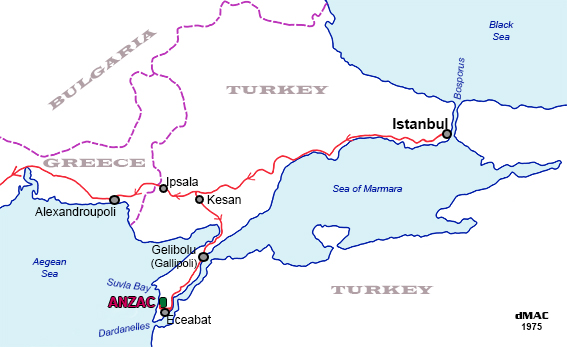
Duncan's route from Istanbul to Anzac Cove - May 1975
Duncan flew to Istanbul from Athens on 2 May 1975. This map shows his route by local bus from Istanbul to Kesan, Galipolu and Eceabat. Then taxi from Eceabat across the Gallipoli Peninsula to Anzac Cove and return. Local bus back to Kesan, Ipsala and Alexandroupoli - then across Greece to Corfu. Ferry to Brindisi in Italy - then Eurail Pass to Rome and across Europe to Bruges in Belgium and ferry to London, arriving on 1st June 1975.
I first read about the Gallipoli campaign in Alan Moorehead's excellent book 'Gallipoli ' in 1956 ~ dMAC

3-May-1975
Istanbul and the Dancing Bear - Blue Mosque in the background
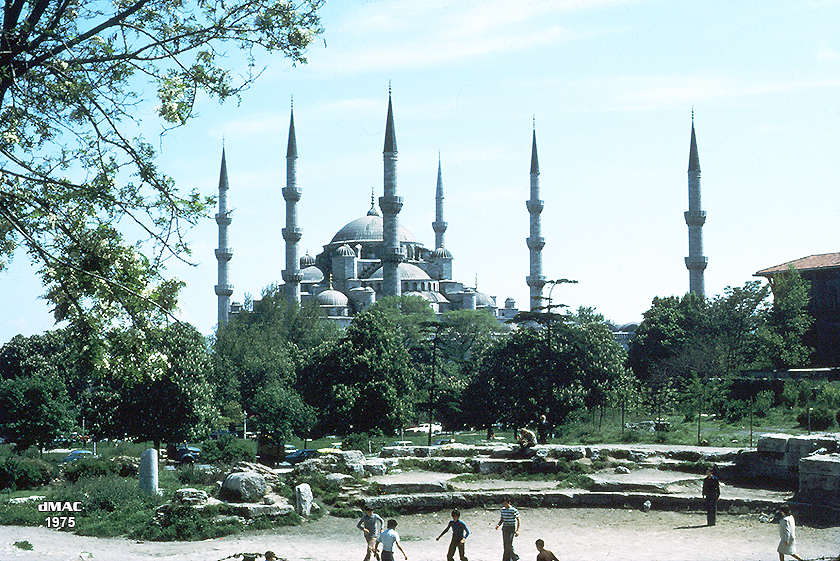
3-May-1975
Istanbul - The Blue Mosque
The Sultan Ahmed Mosque commonly known as the Blue Mosque because of the colour of the interior tiles. It was completed in 1616. Initially there was some controversy over its six minarets - it was common for all mosques to have only four except the Masjid al-Harama, Grand Mosque in Mecca, which had six. The issue was finally settled when an additional minaret was added to Mecca's Grand Mosque giving it seven.
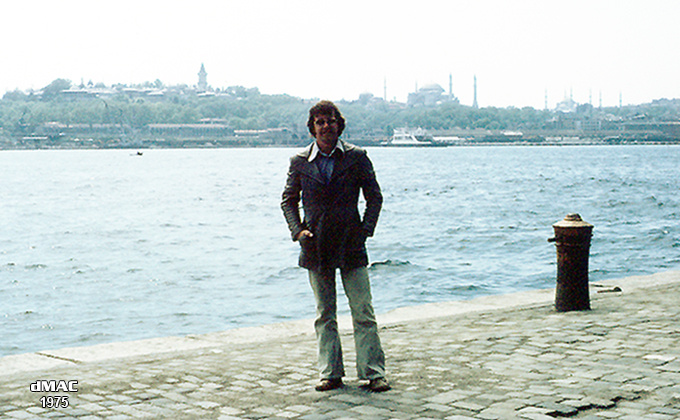
7-May-1975 Duncan against the Istanbul skyline. Topkapi Palace on the left, Hagia Sophia on the right (4 minarets),
Blue Mosque far right (6 minarets).
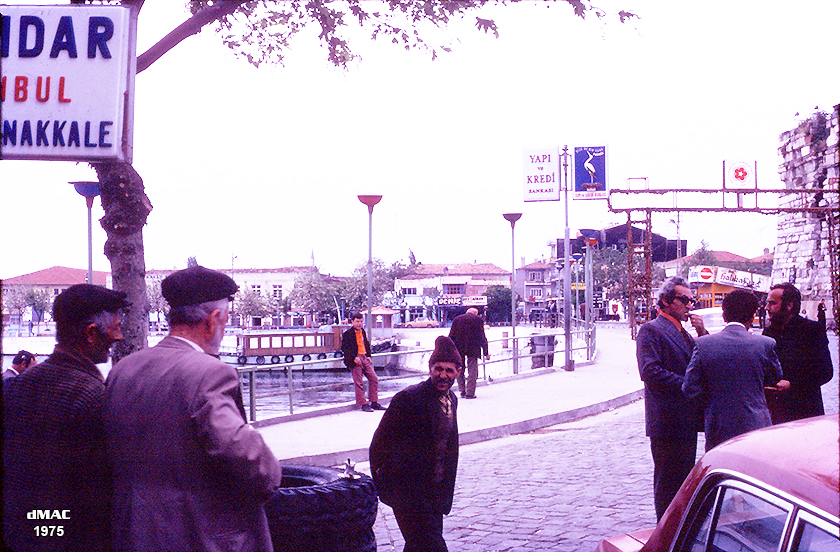
8-May-1975 Gelibolu (Gallipoli) the world famous village on the east coast, population 14,600
While on the local bus, I was becoming concerned because all the road signs in Turkey were in Turkish (naturally). The only one I had recognised was Gelibolu. Around 1:00 pm in the middle of nowhere, I was astounded to see a road sign in English, pointing inland. It read Commonwealth War Graves. Oh well, at least I can go see the war graves - better than nothing, I would get off at the next town which I knew should be Eceabat.Alighting at Eceabat I found a Taksi (taxi). The driver spoke no English - I spoke no Turkish. By means of sign language and my written note he agreed to take me to the Commonwealth War Graves. We agreed on a fee of 50 Lira. The taxi took me back toward Galibolu, until we reached the Commonwealth War Graves sign. Then we turned left and drove overland toward the western coast of the Gallipoli peninsula. The terrain was uninspiring. We came to the coastline and the driver turned north. There was no habitation. I kept my eyes peeled for what could be cemeteries. I assumed (incorrectly) that the grave markers would be white wooden or stone crosses - as in Flanders.
Suddenly as we rounded a headland the terrain changed dramatically. Ahead were towering towering cliffs and deep gullies. I immediately recognised the territory from the black and white photos contained in the book on Gallipoli. I had arrived at Anzac Cove. The war graves were located not in some out of way location, but logically at the battlefield.
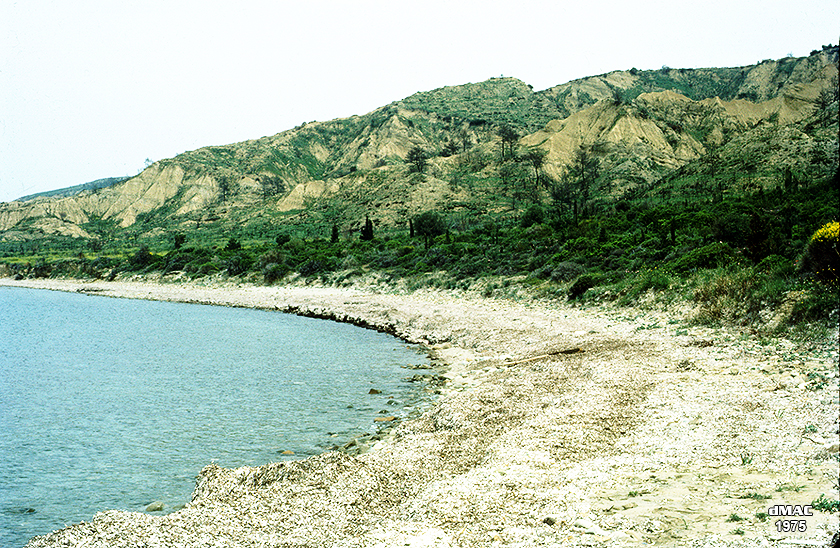
8-May-1975 Anzac Cove - On the beach
I left the taxi and walked along the narrow stony beach. Anzac Cove is 800 metres long. It was totally deserted. The topography on either side of Anzac is undulating countryside. Why troops were landed at this "hell hole" is beyond comprehension. My intial thoughts were: 'If ever a piece of country was designed for human conflict, this is it.'-F.jpg)
Anzac Cove - Johnsons Jolly, the Sphinx
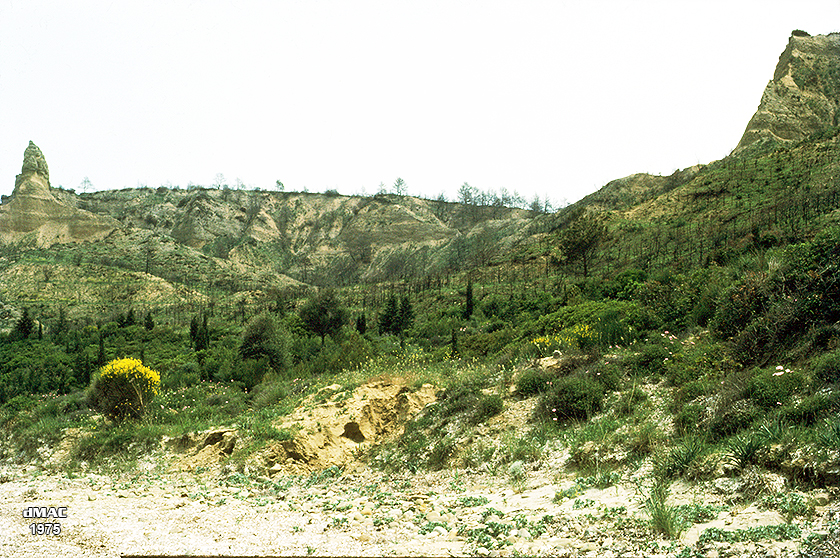
Anzac Cove - the Sphinx, Quinn's Post, Courtney's Post
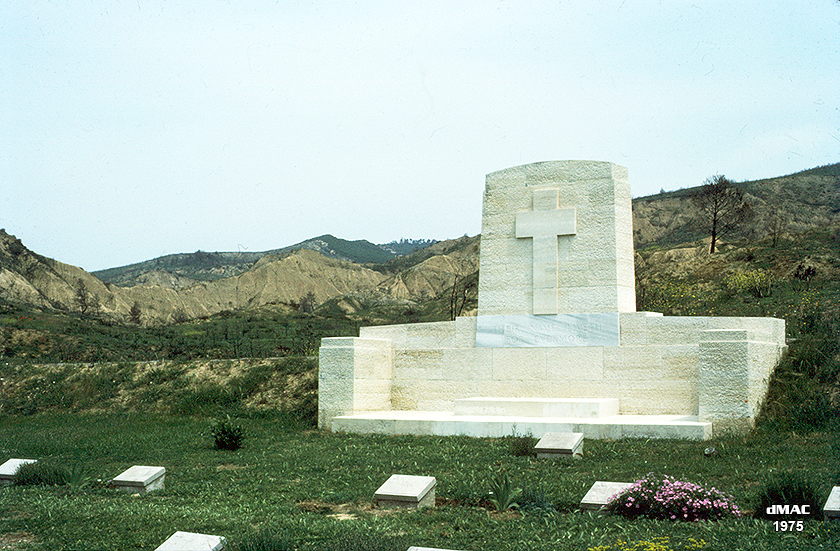
Anzac Cove - New Zealand Memorial
Notice on one of the small cemeteries was typical: 433 soldiers buried. 157 known and graves marked. Names of 207 are known but graves unknown. It wasn't untill 1928 the Australian Government sent teams to locate and formally bury the dead. By that time it was difficult identify the remains - most of the uniforms had disintegrated. Particularly in the upper ridges it was difficult to tell Anzac and Turkish bodies apart.
Anzac Cove - Duncan, in front of Courtney's and Steele's Posts
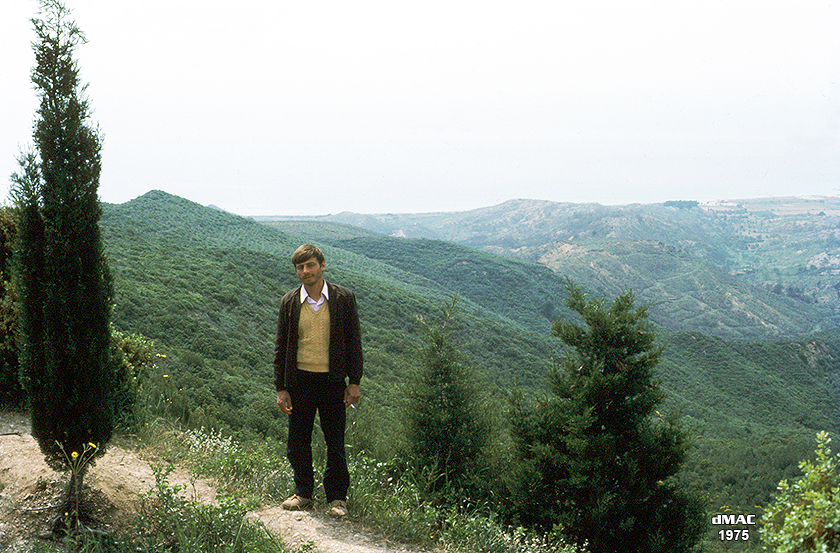
Chanuk Bair looking east - my Turkish taxi driver
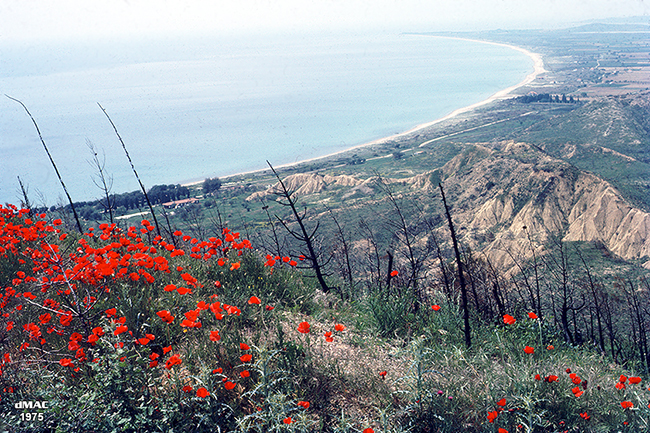
Anzac - Turkish trench - looking north to the Nek and Suvla Bay
I stood in the remains of a Turkish trench looking north over the Nek and could see Suvla Bay in the distance. I was used to the clear skies of Australia and was surprised at the amount of haze that limits one's vision, all along the Mediterrean coast and in most of Europe.
The trench had eroded over the years and was now only waist deep. No doubt in 1915 it would have been 6 to 10 feet deep. Another surprise was the bright red poppies growing on the trench embankment. I had only associated poppies with the fields of Flanders.
While I was standing in the trench on the heights of Gallipoli surrounded by poppies, I experienced something unique - I find it difficult to put into words. I had a sudden feeling I was not alone - there was a presence. I have never experienced that presence before or since.
I feel blessed to have been given the opportunity to visit this very special place.
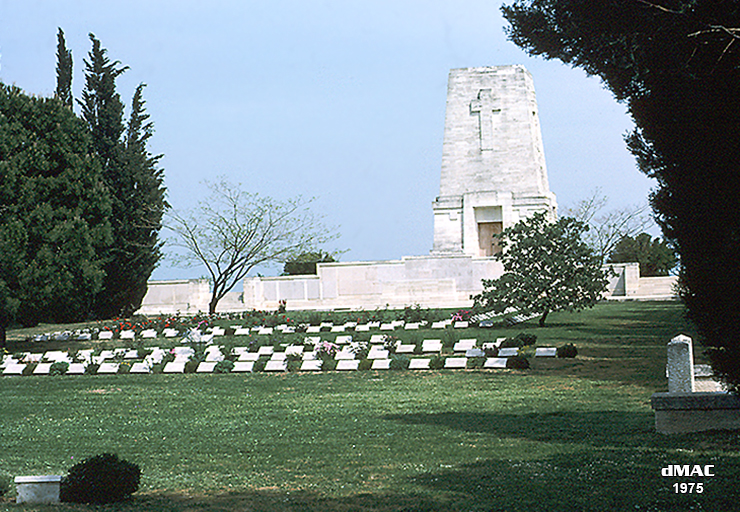
8-May-1975 The Australian Lone Pine Memorial
My next step was to go up to see the battlefield that inspired me to travel to this isolated piece of country: Lone Pine. We drove up to Lone Pine. I was confronted by another cemetery, but this time much, much bigger. The grounds were professionally tended by half a dozen Turkish gardeners.
A large white monument dominated the area. It was the Australian Lone Pine Memorial. On closer inspection I noticed it had a small wooden door. It was padlocked. I discovered the head gardener spoke a little English and I asked if I could go inside.
He said: "No."
I said: "Why not?"
He said: "Chapel locked." I could see I wasn't going to make any headway here, so I wandered off to look at the graves. In fact I was searching for an Anzac who had died on the anniversary of my visit and was my age - 34. Most were aged between 18 and 24 years. I stopped at the gravestone of Private F.J. Pinkney . He had died on 8 May 1915 - 60 years ago and was aged 32.
(Frederick James Pinkney was born in Unley, a suburb of Adelaide, South Australia.)

311 Private F.J. Pinkney, 10th Bn. Australian Inf. 8 May 1915 Age 32
My Turkish taxi driver had watched me seatrching among the gravestones and when I stopped in front of Private Pinkney, he must have thought it was a relative. He picked two purple wildflowers and handed them to me. I'm not really a sentimentalist, but I have to admit I went misty-eyed.
I placed one flower on the gravestone and pressed the second in the back of my travel diary - I still have it.
The driver then had a quiet word with the head gardener and if by magic the gardener found the keys to the 'Chapel' and kindly opened the door. Inside was a very tiny, windowless bare room. The only furniture was a small wooden school desk. On the desk was an ordinary exercise book. It contained names of people who had visited the site (and gained access to the locked 'Chapel'}. The The earliest entry was dated 1938. There were 32 entries. The latest entry near the top of page 2 read:
25 April 1975 - Cutler, VC, AK, KCMG, KCVO, CBE.
It was Sir Roden Cutler, the then Governor of New South Wales. I learnt later he had been taken to Anzac Cove on an Australian Destroyer and carried up-hill to Lone Pine (Cutler lost his right leg in WW2) to celebrate the 60th Anniversary of the landing.
Directly underneath I signed:
8 May 1975 - Duncan MacDonald, Inverell, NSW
* * * * *
Australian soldiers at Gallipoli were ' lions led by donkeys', declared former Turkish Army Colonel Mesut Uyar, who is currently researching the famous campaign in Australia.
(www.news.com.au 22/8/2013)
Postscript
I reached London on 1st June 1975, via Eurail Pass and ferry. My subsequent travels were not as dramatic as those through Turkey, for which I was grateful. However, none of my future travels could compare with the satisfaction of accomplishing
my personal pilgrimage to Anzac Cove and Lone Pine.
* * * * *
The complete Digest of my trip, including my meeting with an original ANZAC in 1974, can be downloaded as a FREE e-book on Smashwords.
Available on iPad / iBooks, Kindle, Nook, Sony, & most e-reading apps including Stanza & Aldiko.
Just click the following link - download free e-book ANZAC & Lone Pine Revisited 1975 click here >>


